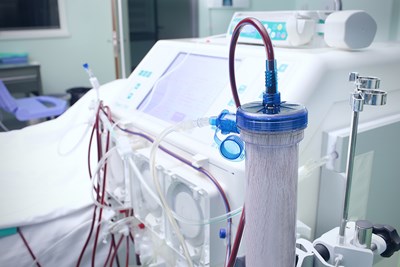Dialysis uses artificial means to perform the function of the kidneys—weeding out waste and excessive fluid from the blood. Several diseases can cause the kidneys to fail, and even medicines, surgeries, and illnesses may shut them down. Although those who need dialysis often face a greater chance of death than the general population, it can still add many years and improve the quality of those years. Sometimes it is only necessary until a kidney transplant is available.
Dialysis Types
There are two types of dialysis: hemodialysis and peritoneal dialysis. Hemodialysis uses an external machine to filter blood. A catheter is placed, the blood is cycled out of the body from the catheter and into the machine, which extracts fluid and waste, and then the blood is sent back into the body through another catheter.
Conversely, peritoneal dialysis uses the tissue membrane of the abdomen, the peritoneum, to act as the kidneys. A special fluid is sent into the abdomen through an abdominal catheter. Combined with the peritoneum’s blood vessels, this fluid attracts the excess waste and water until it is taken back out of the abdomen, through a catheter, into a special bag intended for the purpose.
What is a catheter?
A catheter is a medical device that can serve many purposes, although in this case it is designed to be threaded into the veins to allow easier, more efficient blood flow in either direction. The sites of these catheters, in either type of dialysis, can become infected; this interrupts the flow of treatment, which can be as often as four to six times a week for several hours, depending on circumstances and the type of dialysis.
What is dialysis access?
Dialysis access is intended for hemodialysis. It is a surgical procedure of its own, usually done before the patient is ready for dialysis, to ensure it is healed when it is needed. Instead of the near daily re-threading of the catheter into the veins (which can cause mild damage to the veins and be difficult to do in the same spot over and over, potentially causing discomfort), a surgical procedure creates a permanent entry into the blood vessels of the arm, or sometimes leg, underneath the skin.
The purpose of this access point is to allow a more efficient blood flow. The procedure makes the vessel stronger and larger, which allows for faster, more efficient blood flow into the dialysis machine. The size of the vein, encouraged by the increased blood flow of the connection, further strengthens the vein, making it easier for gentle acceptance of needles needed to get the blood out of the body for cleansing.
Types of Dialysis Access
There are two kinds of dialysis access: a fistula, or a graft. A fistula is a term for a connection made between two points of tissue. It can sometimes be a complication of disorders like inflammatory bowel disease when ulcers eat through the tissue of an organ. However, in this instance, an artery is simply connected to a vein. On the other hand, a graft uses a plastic tube to connect the vein to the artery instead.
Fistulas are preferable because they involve no foreign matter in the body. Unfortunately, they can take significantly longer than a graft to heal. Fistulas, because of this, are also more resistant to infection. Not all veins are appropriate for the fistula procedure, though.




